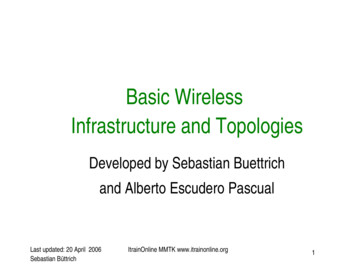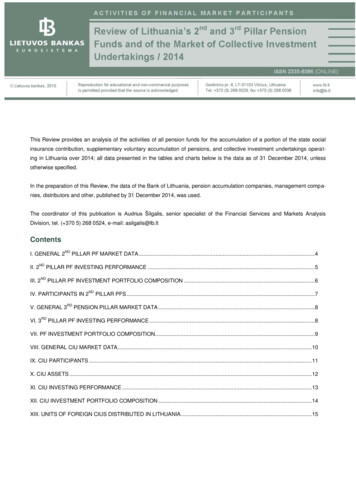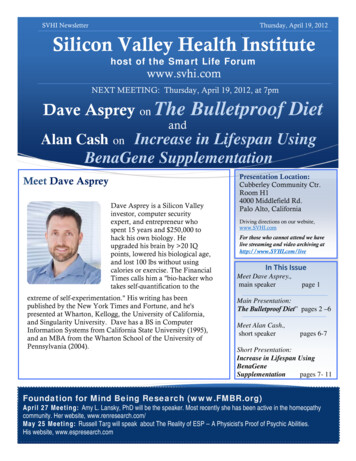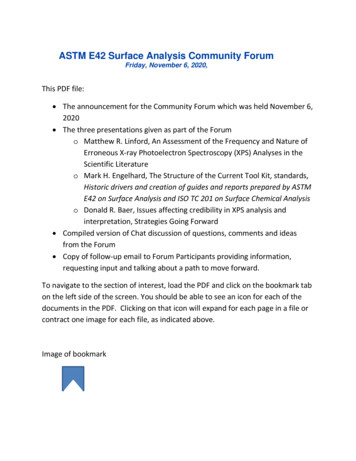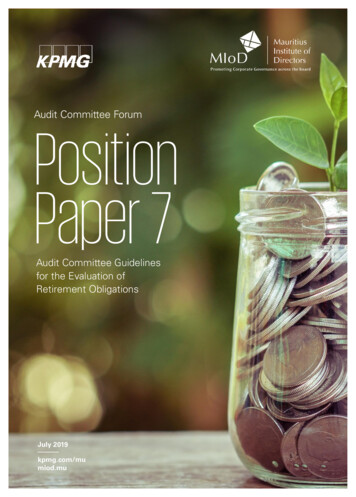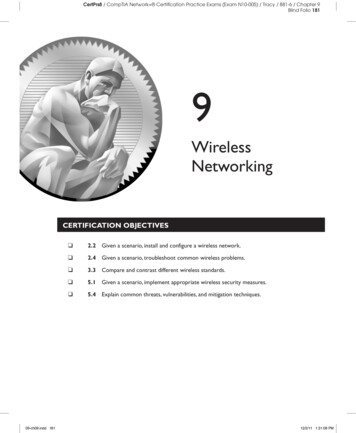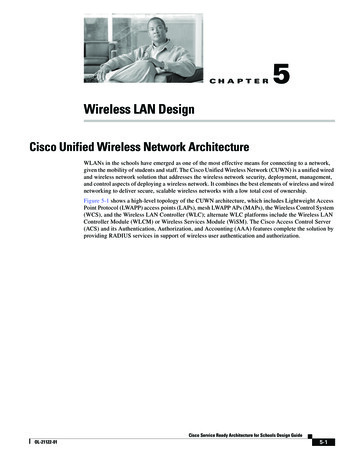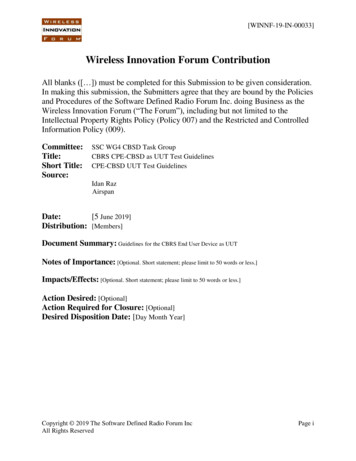
Transcription
[WINNF-19-IN-00033]Wireless Innovation Forum ContributionAll blanks ([ ]) must be completed for this Submission to be given consideration.In making this submission, the Submitters agree that they are bound by the Policiesand Procedures of the Software Defined Radio Forum Inc. doing Business as theWireless Innovation Forum (“The Forum”), including but not limited to theIntellectual Property Rights Policy (Policy 007) and the Restricted and ControlledInformation Policy (009).Committee:Title:Short Title:Source:SSC WG4 CBSD Task GroupCBRS CPE-CBSD as UUT Test GuidelinesCPE-CBSD UUT Test GuidelinesIdan RazAirspanDate:[5 June 2019]Distribution: [Members]Document Summary: Guidelines for the CBRS End User Device as UUTNotes of Importance: [Optional. Short statement; please limit to 50 words or less.]Impacts/Effects: [Optional. Short statement; please limit to 50 words or less.]Action Desired: [Optional]Action Required for Closure: [Optional]Desired Disposition Date: [Day Month Year]Copyright 2019 The Software Defined Radio Forum IncAll Rights ReservedPage i
CBRS CPE-CBSD as UUTTest GuidelinesVersion V1.05 June 2019
CBSD UUT Security Test Cases TutorialTable of ContentsTERMS, CONDITIONS & NOTICES . Error! Bookmark not defined.Contributors . ii1 Introduction .12 Scope .13 References .13.1Normative references .14 Proposed Test Lab Setup for CPE-CBSD as UUT .14.1General Test Lab Setup for CPE-CBSD as UUT .14.2Proposal for “compatible BTS-CBSD” .25 Executing WInnForum SAS - CBSD Protocol Test Cases for CPE-CBSD.56 Proposed Test Method for CPE-CBSD as UUT Transmitting {X Time Out of Y Time}During the Handshake Process .6List of FiguresFigure 1: Proposed Lab Test Setup for CPE-CBSD as UUT. 2Figure 2: CPE-CBSD as UUT, BTS-CBSD direct communication . 3Figure 3: CPE-CBSD as UUT, {BTS-CBSD Domain Proxy} . 4Figure 4: {CPE-CBSD Domain Proxy} as UUT, BTS-CBSD direct communication . 4Figure 5: {CPE-CBSD Domain Proxy} as UUT, {BTS-CBSD Domain Proxy} . 5List of TablesNo table of figures entries found.Page i
CBSD UUT Security Test Cases TutorialContributorsThe following individuals made significant contributions to this document:Idan Raz (Airspan)Page ii
CBSD UUT Security Test Cases TutorialCBRS CPE-CBSD as UUT Test Guidelines1IntroductionThis document provides guidelines for a proposed method of testing CBRS CPE-CBSD as UUTin test labs for FCC Part 96 certification following the publication of FCC KDB 940660 D02CPE-CBSD Handshake Procedures v01.WInnForum SAS Test Harness is developed for test and certification purposes of CBSD/DPUUT. The WInnForum SAS Test Harness is available for download from the GitHub orum/Citizens-Broadband-Radio-Service-DeviceNote: It is recommended to check the GitHub repository as the Test Harness code may haveperiodic updates to address reported items.2ScopeThis document provides test guidelines for CBRS CPE-CBSD as UUT following [n.1] and [n.5].3References3.1 Normative referencesThe following referenced documents are necessary for the application of the present document.[n.1]FCC KDB 940660 D02 CPE-CBSD Handshake Procedures v01, 19 April 2019[n.2]WINNF-TS-0122 Version 1.0.1, “Conformance and Performance Test TechnicalSpecification; CBSD/DP as Unit Under Test (UUT)”, 28 September 2018[n.3]WINNF-IN-0156 Version V1.0.0.1, “WInnForum SAS Test Harness CBSD UUTTutorial”, 2 March 2018[n.4]WINNF-TS-0112 Version V1.X, “Requirements for Commercial Operation in the U.S.3550-3700 MHz Citizens Broadband Radio Service Band”[n.5]FCC KDB 940660 D01 Part 96 CBRS Eqpt v02, 19 April 201944.1Proposed Test Lab Setup for CPE-CBSD as UUTGeneral Test Lab Setup for CPE-CBSD as UUTCPE-CBSD can have direct communication with SAS, or via a Domain Proxy.The proposed test lab setup for CPE-CBSD as UUT includes the following elements:1. “compatible BTS-CBSD”2. WInnForum SAS Test Harness as described in [n.3]Page 1
CBSD UUT Security Test Cases Tutorial3. Radio test equipment required for RF measurements of CPE-CBSD as UUT (the Radiotest equipment is out of the scope of this document)4. Traffic test equipment (including traffic generator) required for testing of user trafficpassing from CPE-CBSD as UUT to its “compatible BTS-CBSD” (the user traffic testequipment including traffic generator is out of scope of this document)Figure 1: Proposed Lab Test Setup for CPE-CBSD as UUTFurther clarification for figure 1: dashed lines represent communication via the RF AirInterface between CPE-CBSD and its “compatible BTS-CBSD”. This communication via the RFAir Interface is passing: User Traffic from CPE-CBSD (Orange color in figure 1)SAS-CBSD protocol interface to/from SAS Test Harness (Red color in figure 1)DP to CBSD vendor proprietary API (Green color in figure 1)4.2 Proposal for “compatible BTS-CBSD”The “compatible BTS-CBSD” is proposed to be an “authorized CBSD” which fulfills thefollowing:1. A BTS-CBSD or {BTS-CBSD Domain Proxy} that has already obtained from the FCCa formal FCC-ID compliant to FCC Part 962. Is operating in the test lab with its own SAS Test Harness separate from the SAS TestHarness for the CPE-CBSD as UUT. The test lab is actually running 2 separateindependent instances/machines of the SAS Test Harness.The following figures provide further clarifications for the lab setup for CPE-CBSD as UUTwith its “compatible BTS-CBSD”. The figures show two separate instances/machines of the SASPage 2
CBSD UUT Security Test Cases TutorialTest Harness: SAS Harness #1 is for the CPE-CBSD UUT, SAS Harness #2 is for the“compatible BTS-CBSD”. SAS Test Harness #1 is running the test cases described in [n.2]. SASTest Harness #2 is running test case WINNF.PT.C.HBT.1.The following table details the possible test setup configurations for communication with theSAS Test Harness:Figure UUT with SAS Test Harness #1“Compatible BTS-CBSD” with SASTest Harness #2#2CPE-CBSD as UUT direct communicationBTS-CBSD direct communication#3CPE-CBSD as UUT direct communication{BTS-CBSD Domain Proxy}#4{CPE-CBSD Domain Proxy} as UUTBTS-CBSD direct communication#5{CPE-CBSD Domain Proxy} as UUT{BTS-CBSD Domain Proxy}The Test Lab needs to setup only one option from the above 4 proposed options. This is based onthe CPE-CBSD vendor and the Test Lab choice for “compatible BTS-CBSD”.Figure 2: CPE-CBSD as UUT, BTS-CBSD direct communicationPage 3
CBSD UUT Security Test Cases TutorialFigure 3: CPE-CBSD as UUT, {BTS-CBSD Domain Proxy}Figure 4: {CPE-CBSD Domain Proxy} as UUT, BTS-CBSD direct communicationPage 4
CBSD UUT Security Test Cases TutorialFigure 5: {CPE-CBSD Domain Proxy} as UUT, {BTS-CBSD Domain Proxy}5Executing WInnForum SAS - CBSD Protocol Test Cases for CPE-CBSDThe test cases for SAS - CBSD protocol in [n.2] apply also for CPE-CBSD device type. TheWinnForum Github SAS Harness applies as is also for CPE-CBSD.Following the FCC KDB 940660 D02 CPE-CBSD Handshake Procedures v01, when running thetest cases in [n.2] for CPE-CBSD device type, the Test Lab for all test cases needs to verify that: CPE-CBSD UUT can begin transmitting its RF only after receiving radio signal from itscompatible BTS-CBSD For all CPE-CBSD RF transmissions, the CPE-CBSD UUT radio frequency range andbandwidth are less or equal to the frequency range and bandwidth of its compatible BTSCBSDFollowing the FCC KDB 940660 D02 CPE-CBSD Handshake Procedures v01, when running thetest cases in [n.2] for CPE-CBSD device type, for the last execution step appearing in [n.2]: The PASS/FAIL criteria “UUT shall not transmit RF” is replaced by “CPE-CBSD UUTshall not transmit user traffic” The PASS/FAIL criteria “UUT shall stop transmission” is replaced by CPE-CBSD UUTshall stop transmitting user traffic”The test methodology described in this section allows the test lab to use the existing WinnForumGithub SAS Harness as is also for CPE-CBSD as UUT. In the WinnForum Github SAS HarnessPage 5
CBSD UUT Security Test Cases Tutorialthe wording of the “yes/no questions” and the correct answer for PASS/FAIL remains the same.It is for the Test Lab personnel to enter the correct answer for CPE-CBSD as UUT based on“user traffic transmission” of the CPE-CBSD. The figures of proposed test setup in the previoussection show “user traffic generator, user traffic test equipment” for this purpose.6Proposed Test Method for CPE-CBSD as UUT Transmitting {X Time Outof Y Time} During the Handshake ProcessFollowing the FCC KDB 940660 D02 CPE-CBSD Handshake Procedures v01, the CPE-CBSDis “limited in duration and duty cycle to the minimum time necessary to get a grant from theSAS; this time should not exceed 1 second within any 10-second period, 10seconds within any300-second period, or 20 seconds within any 3600-second period”.This is an {X Time Out of Y Time} test. The Test Lab needs to create the proper RFenvironment and RF conditions for this test.The following steps are a proposed test method:Step #1: CPE-CBSD as UUT does not receive any RF signal from its “Compatible BTSCBSD”, so CPE-CBSD as UUT does not transmit.Step #2: Use the WinnForum SAS Harness #1 for CPE-CBSD as UUT and run test caseWINNF.FT.C.GRA.1 for CPE-CBSD as UUT.Step #3: CPE-CBSD as UUT starts to receive the RF signal from its “Compatible BTSCBSD”, so CPE-CBSD can start communicating with the WinnForum SAS Harness #1.Make note of the time when RF Test equipment logs the first transmission from CPECBSD which is above 23dBm/10MHz – this is the start time of the {X time out of Ytime}.Step #4: When the test case WINNF.FT.C.GRA.1 finishes and the questions appear onthe WinnForum SAS Harness #1 console, do NOT answer the questions. Wait until Ytime has passed from step #3. During this Y time, the RF test equipment is logging theamount of time CPE-CBSD as UUT transmitted EiRP above 23dBm/10MHz. Theamount of time logged for transmitting EiRP above 23dBm/10MHz is the X time.Step #5: Answer the questions on the WinnForum SAS Harness #1 console so theWinnForum SAS Harness #1 is ready for the next test.Explanation for the procedure above: the {X time out of Y time} is the allowedtransmission time of the CPE-CBSD as UUT prior reaching to AUTHORIZED state.According to [n.3] the WinnForum SAS Harness is built so when the test reaches the“questions phase” it will continue giving specific answers to Request Messages from UUT.Running WINNF.FT.C.GRA.1 will result that CPE-CBSD as UUT will get “stuck” in GrantResponse with responseCode 400 (INTERFERENCE) for the entire Y duration time(never reaching AUTHORIZED or even GRANTED state) which allows to measure the {Xout of Y time} transmission of the CPE-CBSD as UUT.Page 6
and Procedures of the Software Defined Radio Forum Inc. doing Business as the Wireless Innovation Forum (“The Forum”), including but not limited to the Intellectual Property Rights Policy (Policy 007) and the Restricted and Controlled Information Policy (009). Committee: SSC WG4 CB

